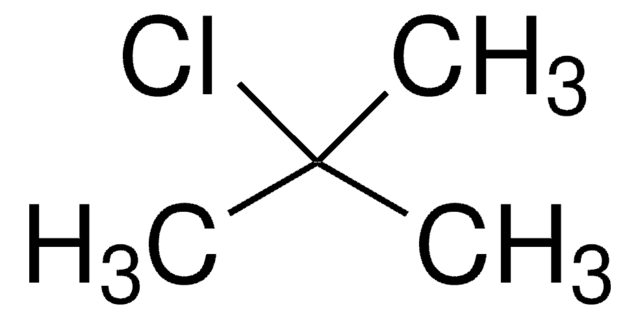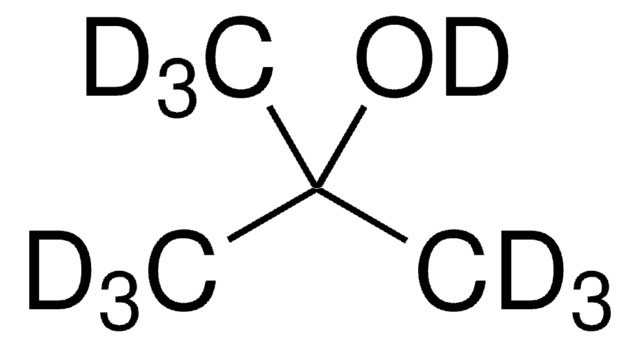308250
terc-Butanol
suitable for HPLC, ≥99.5%
Sinónimos:
2-Metil-2-propanol, Alcohol terc-butilo, Trimetil carbinol
About This Item
Productos recomendados
densidad de vapor
2.5 (vs air)
Nivel de calidad
presión de vapor
31 mmHg ( 20 °C)
44 mmHg ( 26 °C)
Análisis
≥99.5%
formulario
liquid
temp. de autoignición
896 °F
lim. expl.
8 %
técnicas
HPLC: suitable
impurezas
<0.050% water
residuo de evap.
<0.0005%
índice de refracción
n20/D 1.387 (lit.)
pH
7 (20 °C)
bp
83 °C (lit.)
mp
23-26 °C (lit.)
densidad
0.775 g/mL at 25 °C (lit.)
λ
H2O reference
Absorción UV
λ: 215 nm Amax: 1.00
λ: 230 nm Amax: 0.50
λ: 250 nm Amax: 0.20
λ: 300-350 nm Amax: 0.01
aplicaciones
food and beverages
cadena SMILES
CC(C)(C)O
InChI
1S/C4H10O/c1-4(2,3)5/h5H,1-3H3
Clave InChI
DKGAVHZHDRPRBM-UHFFFAOYSA-N
¿Está buscando productos similares? Visita Guía de comparación de productos
Descripción general
Aplicación
Used in the analysis of volatile organic compounds (VOCs) in alcoholic beverages by GC coupled to Flame Ionization Detector (FID).
Palabra de señalización
Danger
Frases de peligro
Consejos de prudencia
Clasificaciones de peligro
Acute Tox. 4 Inhalation - Eye Irrit. 2 - Flam. Liq. 2 - STOT SE 3
Órganos de actuación
Central nervous system, Respiratory system
Código de clase de almacenamiento
3 - Flammable liquids
Clase de riesgo para el agua (WGK)
WGK 1
Punto de inflamabilidad (°F)
59.0 °F - closed cup
Punto de inflamabilidad (°C)
15 °C - closed cup
Certificados de análisis (COA)
Busque Certificados de análisis (COA) introduciendo el número de lote del producto. Los números de lote se encuentran en la etiqueta del producto después de las palabras «Lot» o «Batch»
¿Ya tiene este producto?
Encuentre la documentación para los productos que ha comprado recientemente en la Biblioteca de documentos.
Los clientes también vieron
Protocolos
-Butanol; 2-Methyl-2-butanol; 2-Methyl-1-butanol; 3-Pentanol; 1-Butanol; 2-Methyl-1-propanol; 2-Pentanol, 98%; 3-Methyl-1-butanol; 1-Propanol
Nuestro equipo de científicos tiene experiencia en todas las áreas de investigación: Ciencias de la vida, Ciencia de los materiales, Síntesis química, Cromatografía, Analítica y muchas otras.
Póngase en contacto con el Servicio técnico








